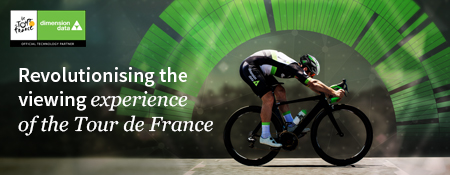DIGITAL SOLUTIONS
A Parisian parade after 21 days of battle – data highlights of the 2017 Tour de France
After Dylan Groenewegen's (TLJ) winning sprint on the Champs-Élysées, it’s time to celebrate the accomplishments of this year’s Tour de France riders, with Chris Froome (SKY) as champion once again.
July 26, 2017

After Dylan Groenewegen’s (TLJ) winning sprint on the Champs-Élysées, it’s time to celebrate the accomplishments of this year’s Tour de France riders, with Chris Froome (SKY) as champion once again. Here are the most striking data bytes we’ve gathered from three weeks of exhilarating action.

The Champs-Élysées turned out to be the avenue of dreams for a rookie, one of the most successful riders of the Tour de France in recent years. Dylan Groenewegen (TLJ) sped up to 59.9km/h to grab his first stage win on one of the most prestigious finish lines in pro cycling. Meanwhile, Chris Froome (SKY) celebrated his historic accomplishment: wearing the Yellow Jersey to Paris for the fourth time, following his overall victories in 2013, 2015, and 2016.
The iconic final stage of the 2017 Tour capped 21 days of intense racing through Germany, Belgium, Luxembourg, and France. As always, the gruelling 3,540km delivered exhausting mountain stages and blazing sprints. Here’s a data breakdown of what happened along the way from Düsseldorf to the Champs-Élysées.

The Tour is always full of surprises, but we had a hunch about many of the outcomes. That’s not only thanks to analysing the tactics and strategies of pro cycling, but also because machine learning provided unprecedented insights into this year’s race.

Our analysis helped us correctly predict the top-placed riders 71.4% of the time.
It also told us that, for instance, Chris Froome (SKY) was the hot favourite for a fourth overall win on the Tour. Fabio Aru (AST) stripped the Yellow Jersey from ‘Froomey’s’ shoulders on two stages. Yet, the British star still came out on top in one of the tightest Tour de France line-ups for the podium ever.

How did Chris Froome (SKY) build this historical victory?
Mainly through individual time trials, also known as ‘the moments of truth’ in pro cycling. The best riders of the Tour were just about evenly matched in the mountains. But when it came to racing solo against the clock, no-one could match Froome’s (SKY) abilities.

There would be no Tour de France without some the most iconic European scenery featuring along the route. The Pyrénees, the imposing mountain range that marks the border between France and Spain, once again saw some brilliant racing this year.

Every rider in the peloton knows the demands of the Pyrénees, but none had ever ridden a stage as short and action-packed as the 13th this year: 101km long, featuring three punishing climbs. Some of the world’s top climbers went on the attack from early on but, fittingly, French favourite Warren Barguil (SUN) won the stage on Bastille Day.

Also winning on top of the (in)famous Col d’Izoard, Warren Barguil (SUN) was eventually designated most aggressive rider on the Tour. His grit, as well as that of some of his rivals in the counterattacks, delivered the most exhilarating live action this year.

High-altitude racing is a different game altogether. Col du Galibier was the loftiest summit of the Tour at 2,642m, and the highest finish line was on top of the Col d’Izoard at 2,360m – two incredible challenges that tested the riders’ limits to the extreme.

As if the iconic Pyrénees and Alps weren’t enough, Tour organisers Amaury Sport Organisation threw down an unprecedented gauntlet of challenges for the riders. This year’s route featured more slopes of more than 15% gradient than ever: brutal for the riders, but delightful for the spectators.

Stage 9 was by far the hardest day of Tour de France 2017: and 4,600m of elevation with three ‘hors catégorie’ climbs, the toughest category in the Tour’s challenges. The stage forced no fewer than 13 riders to throw in the towel on the day. This stage had three tough climbs with gradients of up to 22% (Grand Colombier), but particularly tough was ending on the infamous Mont du Chat, which challenged the tired riders with slopes of up to 15%.

Heavyweight sprinters enjoyed this climbing least of all. But they also had their days of glory … well, mostly Marcel Kittel (QST). The German hero combined raw power with a brilliant understanding of race tactics to win five stages – all of which at speeds of over 60km/h.

Attackers tried to derail the sprinters’ ambitions with long range moves on the flat. But the first week of racing proved it to be a futile mission, with the peloton keeping a tight leash on breakaway attempts.

Blazing speeds can deliver both ecstasy or agony. In the opening time trials, Geraint Thomas (SKY) deftly balanced risk and safety to snatch a win in Düsseldorf. But eight riders weren’t so lucky, with dramatic crashes claiming two of the main contenders for the General Classification: Alejandro Valverde (MOV) and Ion Izaguirre (TBM). They left the Tour having completed only 0.5% of the route.

But how did we make sense of all the action and the data collated across four countries and challenging terrains?
This year, Dimension Data’s Tour de France team united 60 people from around the world across technology, hospitality, the Client Experience Centre, data reporting, and marketing campaign execution teams. And what a ride it’s been!
How data analytics creates real-time race predictions ?
Here’s how we’ve used data in new and exciting ways to revolutionise your viewing experience this year.
[button color=”blue” link=”http://www2.dimensiondata.com/en/tourdefrance/blog/how-data-analytics-creates-real-time-race-predictions”]Read blog ![/button]